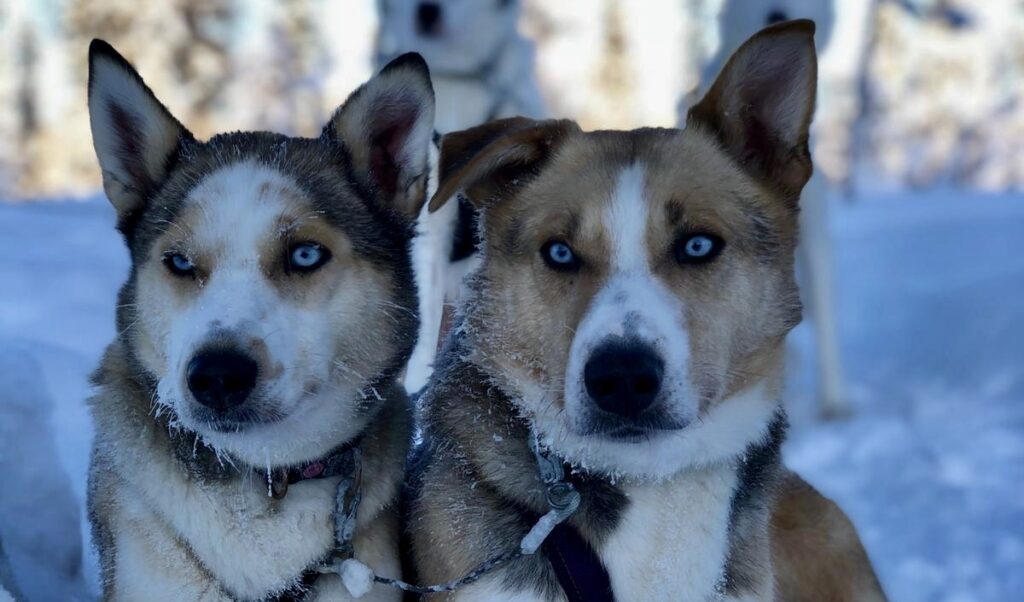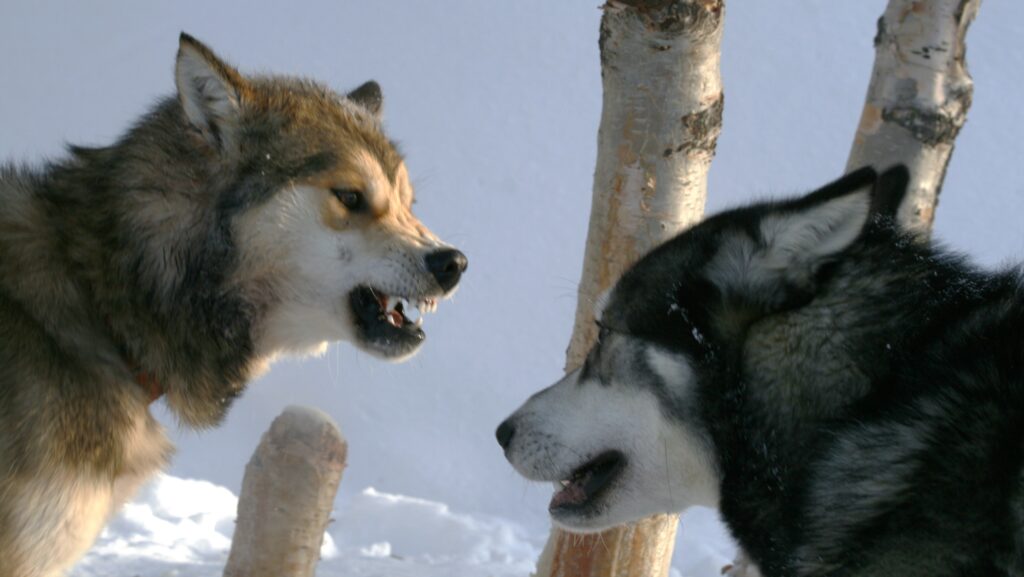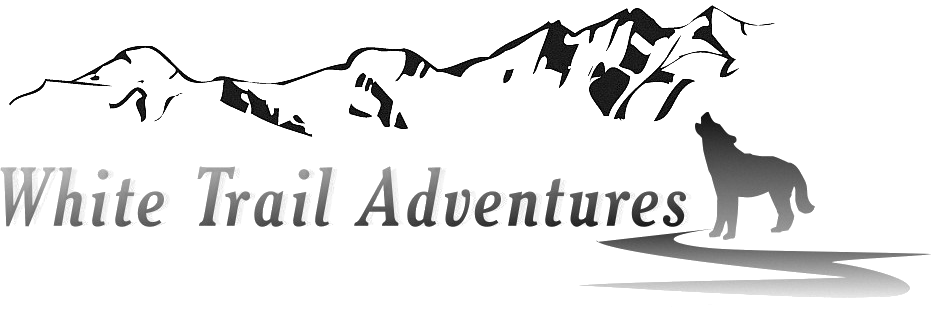
About our dogs
Mental and physical health
The mental and physical health of our dogs is our top priority.
By giving them the opportunity to socialize and live and play with one or more friends, we ensure that our dogs do not feel lonely or live against their natural habits. This keeps their stress levels in the kennel down, which in turn significantly reduces the chances of conflict between dogs. Our young dogs are paired with calm senior dogs, so that they learn to relax and how to behave in the pack and switch off when they are not dog sledding or playing in the free run. With the puppies or young dogs we also go for walks in the forest, so that they can explore their surroundings and get a first impression of what it feels like to wear a harness/collar and be led on a leash.
We have a contract with the local vet so that we only visit this one with our dogs, so they know the dogs and us and can help us in the most efficient way. Of course, all of our dogs have health insurance, they are regularly dewormed and receive professional treatment in case of illness or injury. We have inside boxes in the guide room to accommodate sick dogs and observe them in a warm room. If necessary we take them home to give them the best care. Their fur should be clean and free from anything that affects the dog´s well being. It is obligated to keep the furs natural ability to provide isolation from heat or cold. Claws shall be checked regular and cut if necessary. Gums and teeth shall be healthy and checked regularly. The dogs get bones and wood to chew on to clean the teeth from dental calculus. Especially during the winter period the paws get checked daily to make sure that the dogs do not get cuts or wounds on the feeds, if necessary the dog gets booties and paw cream as long as needed.
Before the new season starts we make sure that all guides are properly introduced to the topics of dog care and dog behaviour and a dog first aid course has been attended.
We have a black board in the guide room with space for notes on each dog (females in heat, which dog needs medication, booties, t-shirts, more or less food etc.). That makes sure that each member of the company is always informed about the special needs of a each dog.
Every dog is different and we have a good eye for the individuals, resulting in dogs wearing different harnesses than the standard ones or having different food because of allergies.
Living conditions
Both in summer and winter the dogs have the opportunity to sleep in their insulated dog houses, which are filled with sawdust and hay (in winter), which is of course included in the animal protection rules from the government. Further do we never transport them in transport boxes longer than 2 h and usually only under special circumstances, for example when we are going on mountain tours.
Our dogs are only on chain when we are out on tour and they don’t provide dog houses, otherwise in our homebase they can move freely in their kennel. If they sleep outside they get hay as a bedding and dogs with short fur even get jackets. Under very cold temperatures dogs with short fur will get jackets when they are out running.
To ensure that all dogs are trained evenly and, in particular, gets enough recovery time, we keep training lists in which we record which dog has run how many km on which days.
If the dogs become seniors we try to let them run as long as possible, very often older dogs only run short tours as additional team members so that they don’t have to pull but can enjoy a nice run. If we realise that they don’t enjoy running and pulling anymore they get retired .We preferably keep them on the yard, where they can live a happy retirement life among their pack. Sometimes they become pet dogs from our guides and handlers. Usually we move them in kennels which are in more action areas, where they can observe peoples activities during the day.
Training
The annual training of the dogs we can divide into three kind of training – puppy-training, autumntraining and leader-training:
- Puppy-training
During puppy-training the puppies first socialise with humans and other dogs, they learn their name and go for short walks. On these walks, they first run free, to learn to stay around humans and to come back when called. Later on, they are getting accustomed with a collar and the leash and one step further with the harness. When they are 8 – 12 months old, depending on the time of the year, they will start training in front of the sled, in a team of experienced dogs. Afterwards, when they are between 10-12 months old and of course always taking into account the individual development, they will start to run on WTA´s shorter tours.
- Autumn-training
According to higher temperatures during the summer months, it is not possible to train the dogs in front of a sled or a quadbike. The risk for overheating a dog is just to high and the only exercise they have is running loose in the freerun areas. In autumn, normally around end of August, when the temperatures are below 12 degrees C, the physical training for all dogs starts again. Before the first snow comes, the dogs are running in front of a quad-bike. Distances start with 5km per run and will increase during the training. First they build up strength during the quadbike training and later, in front of the sled, the necessary speed develops. All this in order to prepare them well for their job during winter time. In total they run approximately 400 km during training, before the season starts.
- Leader-training
Most of the time at the end of the season, but also during the season, promising young dogs will go into leader-training. These leaders are important, as they are working together with the guide, to lead the group or team in a certain direction. When working together with an educated leader dog, all communication is done simply verbal. Newbee leader dogs, normal first work together with an experienced dog, later on they are put in own responsibility. First steps are responding at the crossings on the trails. The advanced state is then to respond in areas with no trails or no visible trails, too.
During the “running season“, between September and April, dogs of around 2 to 9 years old, run around 3000km. Older or younger dogs run on tours, too, but they do a lot less kilometres. The choice of dogs for the tours will be made considering the type of tour, the age and fitness of the dog and the amount of days they have been running before.
Food
We feed the dogs food that is specially developed for sled dogs and their needs, so that our dogs are fit and well for the work they do in winter.
Due to the high amount of energy the dogs need in wintertime and during the autumn training, they are fed with a mix of meat, dry food and water. Water is mixed into the food, as it is not possible to provide a constant access to drinking water in minus temperatures. During summer, the dogs have access to fresh water all day round and are only fed with dry food. Dogs with allergies or old dogs get special food, matching their condition and needs. Every now and then, they get bones, partly as entertainment, but also to „brush their teeth“.
What do the dogs do off season?
In summer the dogs get a well-deserved rest. Although they enjoy winters work, they also enjoy their leisure time. Socialising with other dogs in the freerun, paying with them, just sniffing and digging – all of them important activities in a doglife and important for their social behaviour with other dogs. Young dogs can be introduced to the group in the free-run, as well as dogs that come from other kennels. Some of them even enjoy a nice “catch the ball” game. Besides of letting the dogs out into the freerun areas, the daily care also includes the feeding and the cleaning of the kennels.

